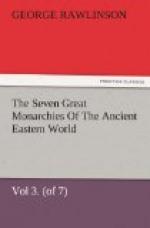We have but little information with respect to the state of the arts among the Medes. A barbaric magnificence characterized, as has been already observed, their architecture, which differed from the Assyrian in being dependent for its effect on groups of pillars rather than on painting or sculpture. Still sculpture was, it is probable, practised to some extent by the Medes, who, it is almost certain, conveyed on to the Persians those modifications of Assyrian types which meet us everywhere in the remains of the Achsemenian monarch? The carving of winged genii, of massive forms of bulls and lions, of various grotesque monsters, and of certain clumsy representations of actual life, imitated from the bas-reliefs of the Assyrians, may be safely ascribed to the Medes; since, had they not carried on the traditions of their predecessors, Persian art could not have borne the resemblance that it does to Assyrian. But these first mimetic efforts of the Arian race have almost wholly perished, and there scarcely seems to remain more than a single fragment which can be assigned on even plausible grounds to the Median period. A portion of a colossal lion, greatly injured by time, is still to be seen at Hamadan, the site of the great Median capital, which the best judges regard as anterior to the Persian period, and as therefore most probably Median. It consists of the head and body of the animal, from which the four legs and the tail have been broken off, and measures between eleven and twelve feet from the crown of the head to the point from which the tail sprang. By the position of the head and what remains of the shoulders and thighs, it is evident that the animal was represented in a sitting posture, with the fore legs straight and the hind legs gathered up under it. To judge of the feeling and general character of the sculpture is difficult, owing to the worn and mutilated condition of the work; but we seem to trace in it the same air of calm and serene majesty that characterizes the colossal bulls and lions of Assyria, together with somewhat more of expression and of softness than are seen in the productions of that people. Its posture, which is unlike that of any Assyrian specimen, indicates a certain amount of originality as belonging to the Median artists, while its colossal size seems to show that the effect on the spectator was still to be produced, not so much by expression, finish, or truth to nature, as by mere grandeur of dimension. [PLATE VI., Fig. 3.]
CHAPTER IV. RELIGION.
The earliest form of the Median religion is to be found in those sections of the Zendavesta which have been pronounced on internal evidence to be the most ancient portions of that venerable compilation; as, for instance, the first Fargard of the Vendidad, and the Gathas, or “Songs,” which occur here and there in the Yacna, or Book on Sacrifice. In the Gathas, which belong to a very remote era indeed,




